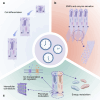The circadian clock in enamel development
- PMID: 39242565
- PMCID: PMC11379899
- DOI: 10.1038/s41368-024-00317-9
The circadian clock in enamel development
Abstract
Circadian rhythms are self-sustaining oscillations within biological systems that play key roles in a diverse multitude of physiological processes. The circadian clock mechanisms in brain and peripheral tissues can oscillate independently or be synchronized/disrupted by external stimuli. Dental enamel is a type of mineralized tissue that forms the exterior surface of the tooth crown. Incremental Retzius lines are readily observable microstructures of mature tooth enamel that indicate the regulation of amelogenesis by circadian rhythms. Teeth enamel is formed by enamel-forming cells known as ameloblasts, which are regulated and orchestrated by the circadian clock during amelogenesis. This review will first examine the key roles of the circadian clock in regulating ameloblasts and amelogenesis. Several physiological processes are involved, including gene expression, cell morphology, metabolic changes, matrix deposition, ion transportation, and mineralization. Next, the potential detrimental effects of circadian rhythm disruption on enamel formation are discussed. Circadian rhythm disruption can directly lead to Enamel Hypoplasia, which might also be a potential causative mechanism of amelogenesis imperfecta. Finally, future research trajectory in this field is extrapolated. It is hoped that this review will inspire more intensive research efforts and provide relevant cues in formulating novel therapeutic strategies for preventing tooth enamel developmental abnormalities.
© 2024. The Author(s).
Conflict of interest statement
The authors declare no competing interests.
Figures






Similar articles
-
The tick tock of odontogenesis.Exp Cell Res. 2014 Jul 15;325(2):83-9. doi: 10.1016/j.yexcr.2014.02.007. Epub 2014 Feb 25. Exp Cell Res. 2014. PMID: 24582863 Free PMC article. Review.
-
MEMO1 Is Required for Ameloblast Maturation and Functional Enamel Formation.J Dent Res. 2023 Oct;102(11):1261-1271. doi: 10.1177/00220345231185758. Epub 2023 Jul 20. J Dent Res. 2023. PMID: 37475472 Free PMC article.
-
Circadian rhythms regulate amelogenesis.Bone. 2013 Jul;55(1):158-65. doi: 10.1016/j.bone.2013.02.011. Epub 2013 Feb 26. Bone. 2013. PMID: 23486183 Free PMC article.
-
Circadian rhythms and gene expression during mouse molar tooth development.Acta Odontol Scand. 2017 Mar;75(2):144-153. doi: 10.1080/00016357.2016.1271999. Epub 2016 Dec 28. Acta Odontol Scand. 2017. PMID: 28030993
-
Regulation of pH During Amelogenesis.Calcif Tissue Int. 2010 Feb;86(2):91-103. doi: 10.1007/s00223-009-9326-7. Epub 2009 Dec 17. Calcif Tissue Int. 2010. PMID: 20016979 Free PMC article. Review.
Cited by
-
The role of the TGF-β1 signaling pathway in the process of amelogenesis.Front Physiol. 2025 Apr 9;16:1586769. doi: 10.3389/fphys.2025.1586769. eCollection 2025. Front Physiol. 2025. PMID: 40271211 Free PMC article. Review.
-
ADAM10 Expression by Ameloblasts Is Essential for Proper Enamel Formation.Int J Mol Sci. 2024 Dec 7;25(23):13184. doi: 10.3390/ijms252313184. Int J Mol Sci. 2024. PMID: 39684894 Free PMC article.
References
Publication types
MeSH terms
LinkOut - more resources
Full Text Sources

